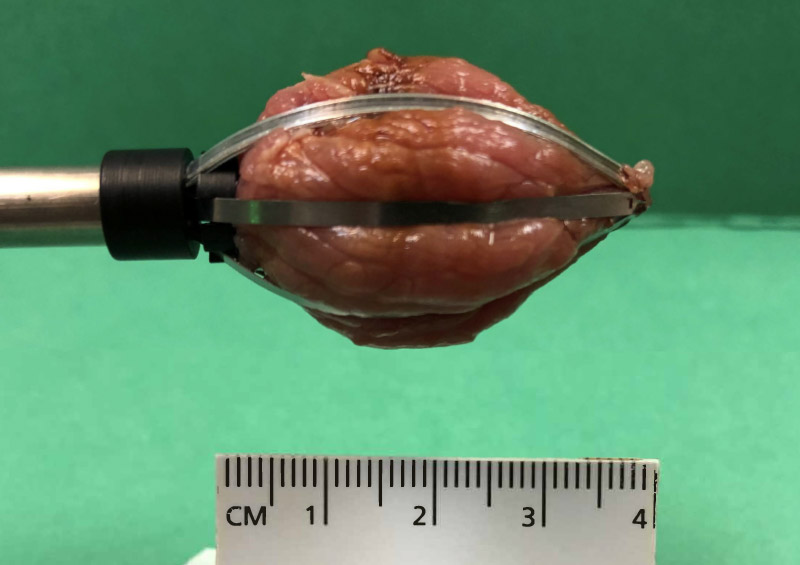Developed over seven years and internally funded by our dedicated medical product development team, the first issued U.S. Patent No. 11,737,808 for the Neocision System discloses an apparatus, system and method for the minimally invasive recovery of an intact volume of tissue. A single-use tissue cutting and capture assembly, supported by a reusable battery-powered handpiece, is positioned in confronting adjacency with the volume of tissue to be recovered.
Once in position, a tissue cutting and capture assembly formed of a plurality of metal leafs is deployed from the distal end of the delivery cannula. The tips of these leafs carry a pursing cable assembly, which is resistively heated by the passage of electrical current exclusively through the cable, attaining a temperature level sufficient to thermally cut around and circumscribe the targeted tissue volume. These pursing cables are tensioned to complete the envelopment of the tissue volumes by drawing the leaf tips together.
In addition to the first issued patent, Neocision Medical has received a Notice of Allowance from the U.S. Patent Office for a second pending patent application. Also, two addition U.S. Patent Applications are pending along with the filing of multiple foreign patent applications.

25mm Diameter Tissue Capture Using Wand
Mission
Empowering surgeons and radiologists with an innovative, minimally invasive solution to transform breast cancer treatment.
The Problem
Each year, an estimated 3 to 5 million minimally invasive needle biopsy procedures and 1 to 1.5 million breast conserving surgeries are performed each year in the field of breast cancer diagnosis and treatment.
Breast conserving surgery (BCS or Lumpectomy) is a complex and expensive procedure that is performed in an operating room while the patient is under general anesthesia.
The first step in existing BCS procedures is to locate the vicinity of the lesion in a Radiology department of the hospital and the placement of the distal end of a marker wire at the site of the lesion within the breast. The second step requires the patient to be transferred to an operating room wherein total anesthesia is administered. During anesthesia, a surgeon incises the breast tissue to reach the distal end of the marker wire and then excises breast tissue in the region around the distal end of the marker wire to attempt the complete removal of the lesion while achieving positive margins between the lesion and the boundary of the excised breast tissue.

The overall process for the existing BCS procedure is time consuming. The first step, the placement of a localization wire in the breast, requires about 30 minutes in the Radiology department followed by transport of the patient to the operating room. In the second step performed in the operating room, anesthesia is administered and the surgeon proceeds to excise breast tissue that surrounds the distal end of the distal end of the marker wire in an attempt to achieve positive margins between the lesion and the boundary of the excised tissue. The second surgical excision step and wound closure requires about 30 minutes. In an attempt to achieve clear margins, the surgical excision often removes excess breast tissue, thereby adversely impairing the aesthetic outcome.
In addition to the expense and staff time required for a BCS procedure, a significant cost and psychological burden to the patient is the need, as often as 20% of cases, for repeating the BCS procedure in an attempt to excise all of the malignant tissue in the event a positive margin is not achieved in the initial excision.
The Solution
The hand-held Neocision System comprises a reusable, battery-powered Handpiece and a single-use Wand, percutaneously excises, under image guidance and the use of local anesthetic, a lesion-containing tissue volume as large as 30mm through a small entry incision. This eliminates the need for implantation of a marker wire and reduces procedure times to less than 15 minutes. The Neocision System procedure enables the excision procedure to optionally be performed in an out-patient setting. Once the distal end of the Wand is positioned adjacent to the targeted lesion, the fully automated tissue capture process is actuated and requires only about 20 seconds while the operator holds the Handpiece in position. Upon illumination of the “Capture Complete” indicator light, the operator simply withdraws the Wand and captured tissue specimen from the breast.
Through the proper selection of the tissue capture diameter by the physician (in the range from 15 to 30 mm) combined with real-time ultrasound guidance, more accurate excision of the target lesion is achieved requiring fewer secondary re-excision procedures.